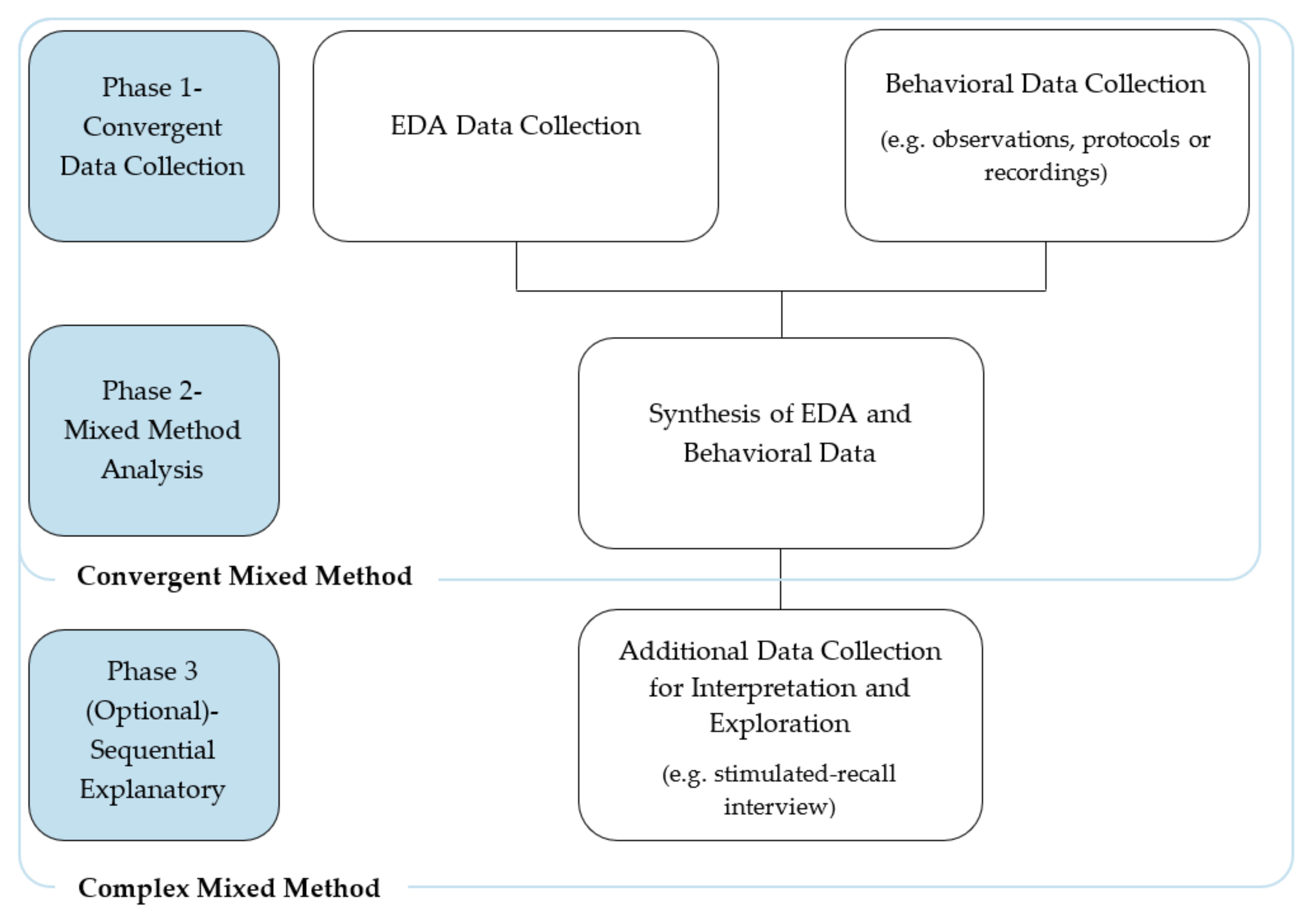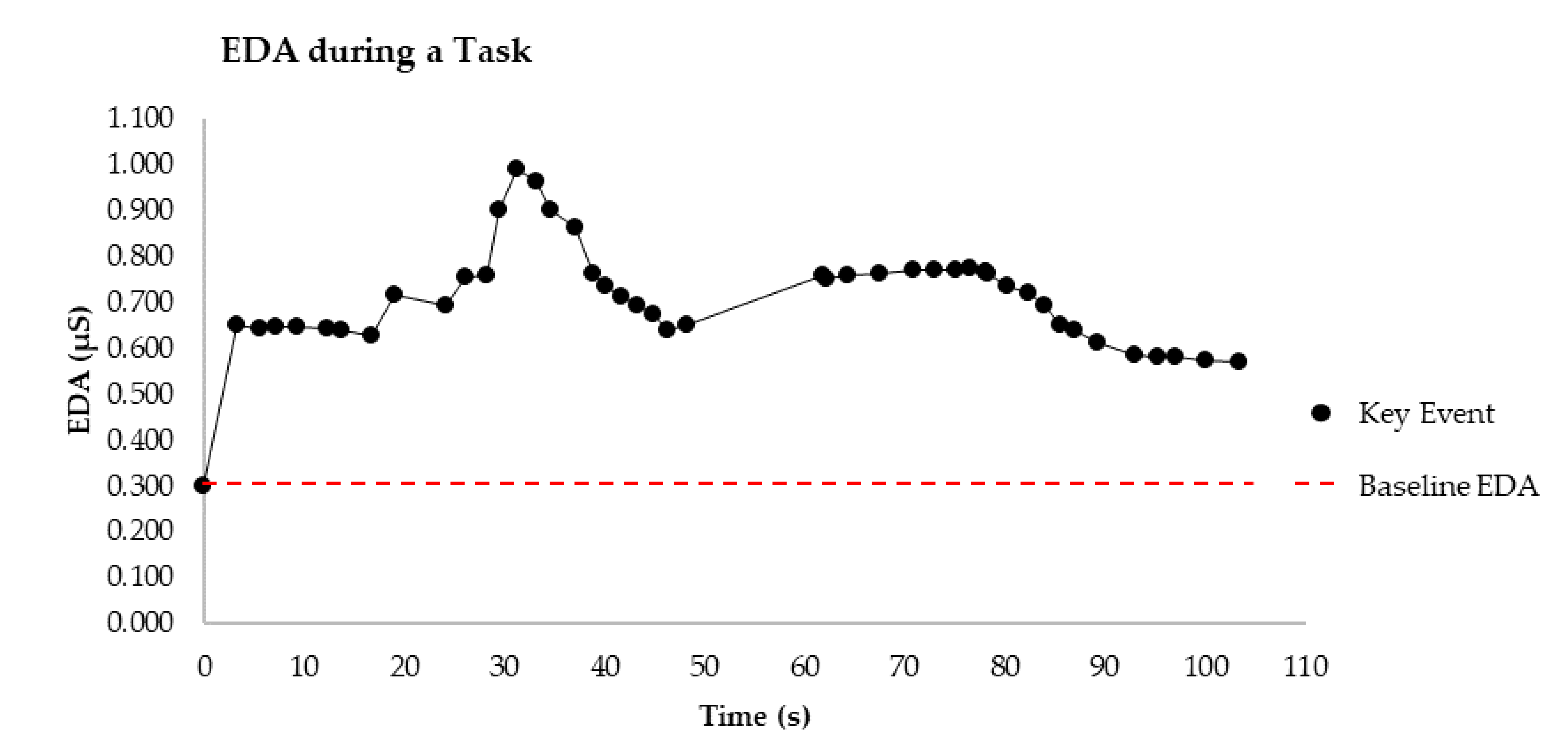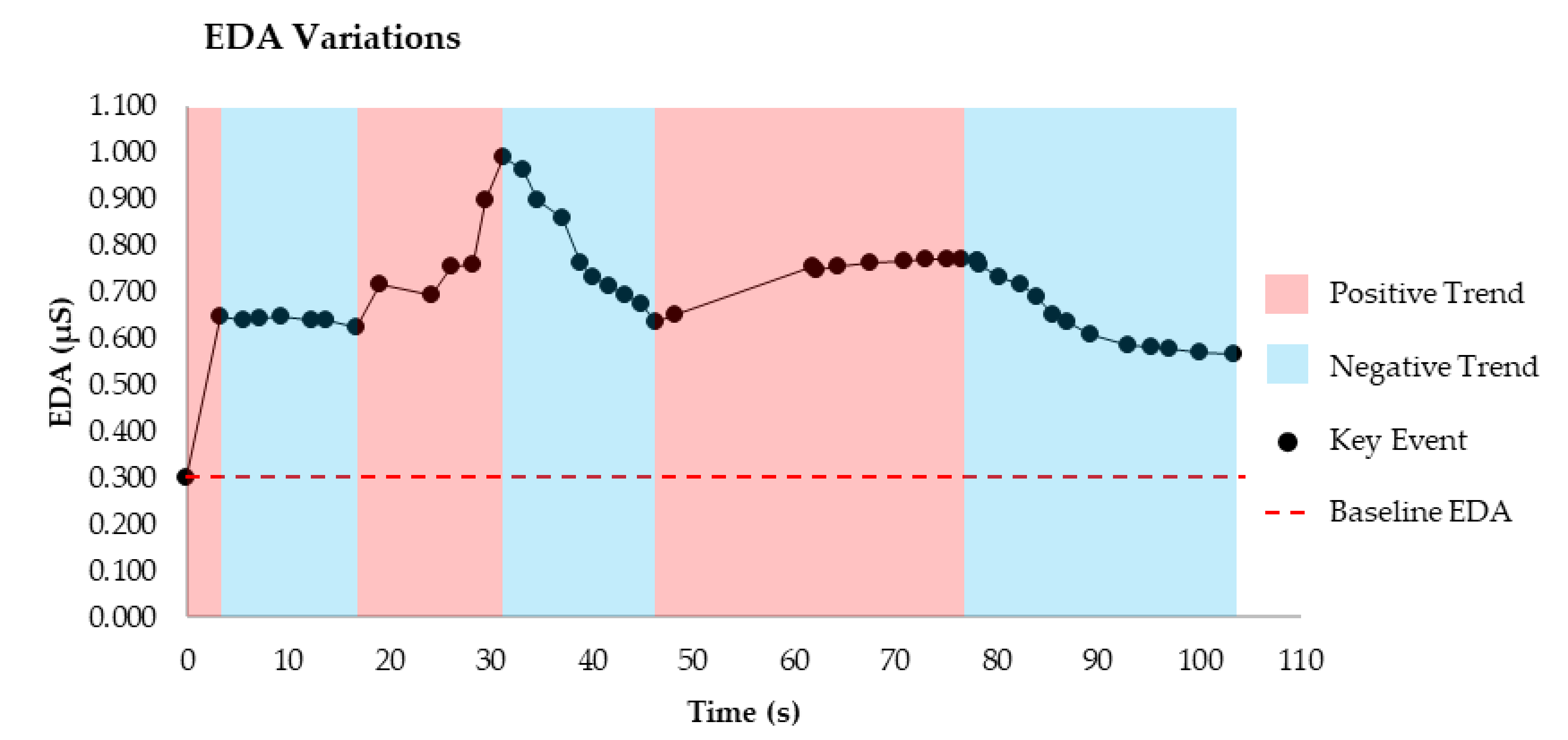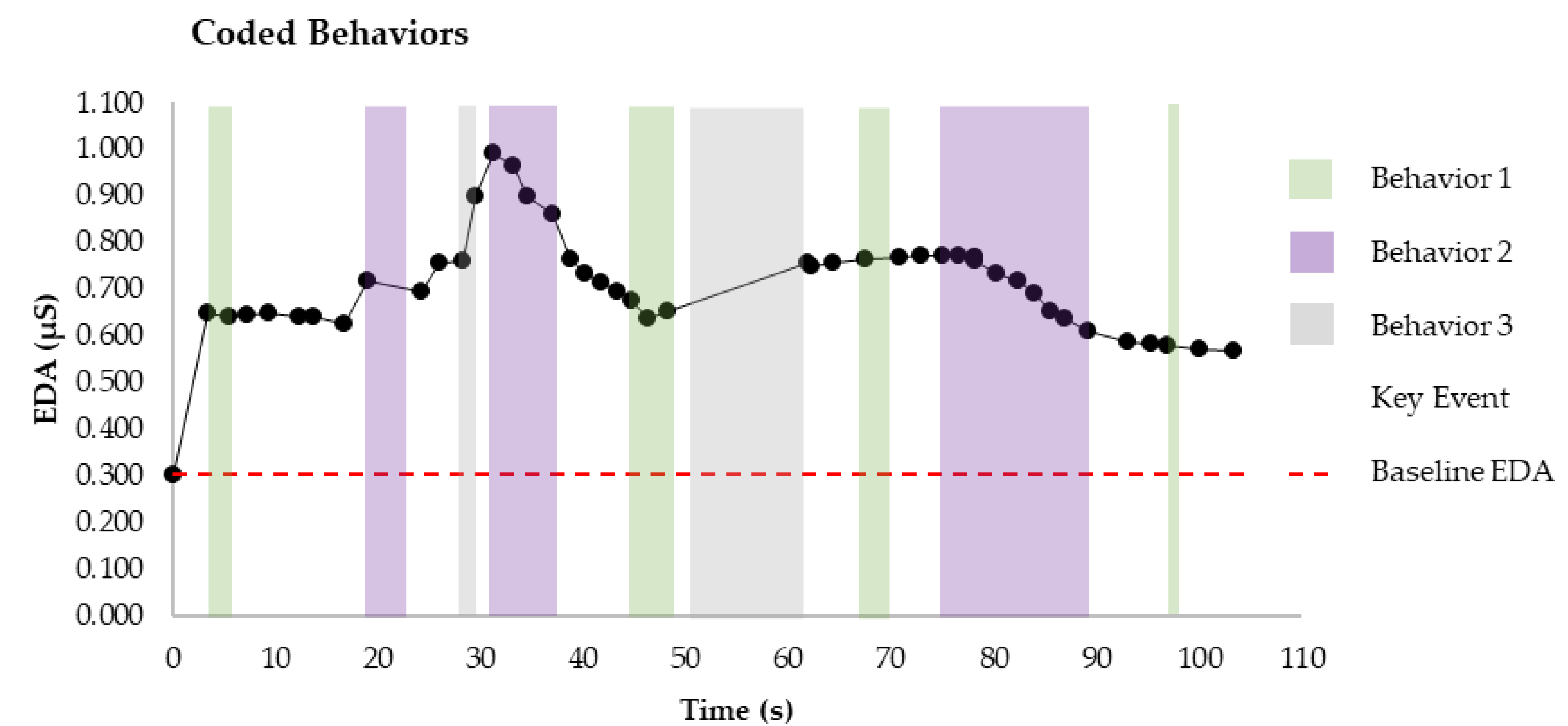A Novel Mixed Methods Approach to Synthesize EDA Data with Behavioral Data to Gain Educational Insight
Abstract
1. Introduction
2. Research Context and Methodological Requirements
2.1. Cognitive Load in Education
2.1.1. Subjective Measures
2.1.2. Objective Measures
3. The Mixed Methods Approach
3.1. Phase 1—Convergent Data Collection
3.1.1. Observing Behaviors
3.1.2. Collecting EDA Data
3.2. Phase 2—Mixed Method Analysis
Graphical Interpretation of EDA Data
3.3. Phase 3 (Optional)—Sequential Explanatory Data Collection
4. Added Research Value and Conclusions
Author Contributions
Funding
Acknowledgments
Conflicts of Interest
References
- Thammasan, N.; Stuldreher, I.V.; Schreuders, E.; Giletta, M.; Brouwer, A.M. A usability study of physiological measurement in school using wearable sensors. Sensors 2020, 20, 5380. [Google Scholar] [CrossRef]
- Son, J.; Park, M. Estimating cognitive load complexity using performance and physiological data in a driving simulator. In Proceedings of the Automotive User Interfaces and Interactive Vehicular Applications Conference, Salzburg, Austria, 29 November–2 December 2011. [Google Scholar]
- Setz, C.; Arnrich, B.; Schumm, J.; la Marca, R.; Tr, G.; Ehlert, U. Discriminating stress from cognitive load using a wearable EDA device. Technology 2010, 14, 410–417. [Google Scholar] [CrossRef]
- Paletta, L.; Pittino, N.M.; Schwarz, M.; Wagner, V.; Kallus, K.W. Human Factors Analysis Using Wearable Sensors in the Context of Cognitive and Emotional Arousal. Procedia Manuf. 2015, 3, 3782–3787. [Google Scholar] [CrossRef]
- Henriques, R.; Paiva, A.; Antunes, C. On the need of new methods to mine electrodermal activity in emotion-centered studies. In Agents and Data Mining Interaction; Cao, L., Zeng, Y., Symeonidis, A.L., Gorodetsky, V.I., Yu, P.S., Singh, M.P., Eds.; Springer: Berlin, Germany, 2013; Volume 7607, pp. 203–215. [Google Scholar]
- Gjoreski, M.; Luštrek, M.; Gams, M.; Gjoreski, H. Monitoring stress with a wrist device using context. J. Biomed. Inform. 2017, 73, 159–170. [Google Scholar] [CrossRef]
- Keighrey, C.; Flynn, R.; Murray, S.; Murray, N. A Physiology-based QoE Comparison of Interactive Augmented Reality, Virtual Reality and Tablet-based Applications. IEEE Trans. Multimed. 2020. [Google Scholar] [CrossRef]
- Posada-Quintero, H.F.; Chon, K.H. Innovations in electrodermal activity data collection and signal processing: A systematic review. Sensors 2020, 20, 479. [Google Scholar] [CrossRef] [PubMed]
- Cain, R.; Lee, V.R. Measuring Electrodermal Activity in an Afterschool Maker Program to Detect Youth Engagement. In Cognitive and Affective Perspectives on Immersive Technology in Education; Zheng, R.Z., Ed.; IGI Global: Hershey, PA, USA, 2020; pp. 128–150. [Google Scholar]
- Boucsein, W.; Fowles, D.C.; Grimnes, S.; Ben-Shakhar, G.; Roth, W.T.; Dawson, M.E.; Filion, D.L. Publication recommendations for electrodermal measurements. Psychophysiology 2012, 49, 1017–1034. [Google Scholar] [PubMed]
- Poh, M.Z.; Swenson, N.C.; Picard, R.W. A wearable sensor for unobtrusive, long-term assesment of electrodermal activity. IEEE Trans. Biomed. Eng. 2010, 57, 1243–1252. [Google Scholar]
- Benedek, M.; Kaernbach, C. A continuous measure of phasic electrodermal activity. J. Neurosci. Methods 2010, 190, 80–91. [Google Scholar] [CrossRef]
- Liu, Y.; Du, S. Psychological stress level detection based on electrodermal activity. Behav. Brain Res. 2018, 341, 50–53. [Google Scholar] [CrossRef]
- Villanueva, I.; Campbell, B.D.; Raikes, A.C.; Jones, S.H.; Putney, L.A.G. A Multimodal Exploration of Engineering Students’ Emotions and Electrodermal Activity in Design Activities. J. Eng. Educ. 2018, 107, 414–441. [Google Scholar] [CrossRef]
- Khan, T.H.; Villanueva, I.; Vicioso, P.; Husman, J. Exploring relationships between electrodermal activity, skin temperature, and performance during engineering exams. In Proceedings of the 2019 IEEE Frontiers in Education Conference (FIE), Covington, KY, USA, 16–19 October 2019. [Google Scholar]
- Anvari, F.; Tran, H.M.T.; Kavakli, M. Using Cognitive Load Measurement and Spatial Ability Test to Identify Talented Students in Three-Dimensional Computer Graphics Programming. Int. J. Inf. Educ. Technol. 2013, 3, 94–99. [Google Scholar] [CrossRef]
- Nourbakhsh, N.; Wang, Y.; Chen, F.; Calvo, R.A. Using galvanic skin response for cognitive load measurement in arithmetic and reading tasks. In Proceedings of the 24th Australian Computer-Human Interaction Conference, Melbourne, Australia, 26–30 November 2012; pp. 420–423. [Google Scholar]
- Creswell, J.W.; Creswell, J.D. Research Design: Qualitative, Quantitative, and Mixed Methods Approaches, 5th ed.; Sage Publication: Thousand Oaks, CA, USA, 2018. [Google Scholar]
- Sweller, J.; van Merriënboer, J.J.G.; Paas, F. Cognitive Architecture and Instructional Design: 20 Years Later. Educ. Psychol. Rev. 2019, 31, 261–292. [Google Scholar] [CrossRef]
- Chen, O.; Kalyuga, S. Cognitive Load Theory, Spacing Effect, and Working Memory Resources Depletion: Implications for Instructional Design. In Form, Function, and Style in Instructional Design: Emerging Research and Opportunities; IGI Global: Hershey, PA, USA, 2020; pp. 1–26. [Google Scholar]
- Paas, F.; Renkl, A.; Sweller, J. Cognitive load theory: Instructional implications of the interaction between information structures and cognitive architecture. Instr. Sci. 2004, 32, 1–8. [Google Scholar] [CrossRef]
- Paas, F.; Renkl, A.; Sweller, J. Cognitive Load Theory and Instructional Design: Recent Developments. Educ. Psychol. 2003, 38, 1–4. [Google Scholar] [CrossRef]
- Brünken, R.; Plass, J.L.; Leutner, D. Direct measurement of cognitive load in multimedia learning. Educ. Psychol. 2003, 38, 53–61. [Google Scholar] [CrossRef]
- Cohen, L.; Manion, L.; Morrison, K. Research Methods in Education, 8th ed.; Routledge: Oxford, UK, 2018. [Google Scholar]
- Kalyuga, S.; Plass, J.L. Cognitive Load as a Local Characteristic of Cognitive Processes: Implications for Measurement Approaches. In Cognitive Load Measurement and Application: A Theoretical Framework for Meaningful Research and Practice; Zheng, R.Z., Ed.; Routledge: New York City, NY, USA, 2017; pp. 73–88. [Google Scholar]
- Leppink, J.; Paas, F.; van der Vleuten, C.P.M.; van Gog, T.; van Merriënboer, J.J.G. Development of an instrument for measuring different types of cognitive load. Behav. Res. Methods 2013, 45, 1058–1072. [Google Scholar] [CrossRef]
- Leppink, J.; van Merrienboer, J.J.G. The Beast of Aggregating Cognitive Load Measures in Technology-Based Learning. Educ. Technol. Soc. 2015, 18, 230–245. [Google Scholar]
- Paas, F.; Tuovinen, J.E.; Tabbers, H.; van Gerven, P.W.M. Cognitive load measurement as a means to advance cognitive load theory. Educ. Psychol. 2003, 38, 63–71. [Google Scholar] [CrossRef]
- Van Merriënboer, J.J.G.; Sweller, J. Cognitive load theory and complex learning: Recent developments and future directions. Educ. Psychol. Rev. 2005, 17, 147–177. [Google Scholar] [CrossRef]
- Leppink, J.; Paas, F.; van Gog, T.; van der Vleuten, C.P.M.; van Merriënboer, J.J.G. Effects of pairs of problems and examples on task performance and different types of cognitive load. Learn. Instr. 2014, 30, 32–42. [Google Scholar] [CrossRef]
- Hart, S.G.; Staveland, L.E. Development of NASA-TLX (Task Load Index): Results of Empirical and Theoretical Research. Adv. Psychol. 1988, 52, 139–183. [Google Scholar]
- Paas, F.G.W.C. Training Strategies for Attaining Transfer of Problem-Solving Skill in Statistics: A Cognitive-Load Approach. J. Educ. Psychol. 1992, 84, 429–434. [Google Scholar] [CrossRef]
- Beers, P.J.; Boshuizen, H.P.A.; Kirschner, P.A.; Gijselaers, W.; Westendorp, J. Cognitive load measurements and stimulated recall interviews for studying the effects of information and communications technology. Educ. Technol. Res. Dev. 2008, 56, 309–328. [Google Scholar] [CrossRef][Green Version]
- Jenkinson, J. Measuring the Effectiveness of Educational Technology: What are we Attempting to Measure? Electron. J. e-Learn. 2009, 7, 273–280. [Google Scholar]
- Prokop, M.; Pilař, L.; Tichá, I. Impact of think-aloud on eye-tracking: A comparison of concurrent and retrospective think-aloud for research on decision-making in the game environment. Sensors 2020, 20, 2750. [Google Scholar] [CrossRef]
- Barkaoui, K. Think-aloud protocols in research on essay rating: An empirical study of their veridicality and reactivity. Lang. Test. 2011, 28, 51–75. [Google Scholar] [CrossRef]
- Paskins, Z.; Sanders, T.; Croft, P.R.; Hassell, A.B. Exploring the Added Value of Video-Stimulated Recall in Researching the Primary Care Doctor–Patient Consultation: A Process Evaluation. Int. J. Qual. Methods 2017, 16. [Google Scholar] [CrossRef]
- Paas, F.G.W.C.; van Merriënboer, J.J.G. Variability of Worked Examples and Transfer of Geometrical Problem-Solving Skills: A Cognitive-Load Approach. J. Educ. Psychol. 1994, 86, 122–133. [Google Scholar] [CrossRef]
- Solhjoo, S.; Haigney, M.C.; McBee, E.; van Merrienboer, J.J.G.; Schuwirth, L.; Artino, A.R.A., Jr.; Battista, A.; Ratcliffe, T.A.; Lee, H.D.; Durning, S.J. Heart Rate and Heart Rate Variability Correlate with Clinical Reasoning Performance and Self-Reported Measures of Cognitive Load. Sci. Rep. 2019, 9, 14668. [Google Scholar] [CrossRef]
- Nourbakhsh, N.; Wang, Y.; Chen, F. GSR and blink features for cognitive load classification. In Proceedings of the IFIP Conference on Human-Computer Interaction, Cape Town, South Africa, 2–6 September 2013; pp. 159–166. [Google Scholar]
- Flick, U. An Introduction to Qualitative Research, 5th ed.; Sage: London, UK, 2014. [Google Scholar]
- Braithwaite, J.; Watson, D.; Robert, J.; Mickey, R. A Guide for Analysing Electrodermal Activity (EDA) & Skin Conductance Responses (SCRs) for Psychological Experiments; Technical report; University of Birmingham: Birmingham, UK, 2013. [Google Scholar]
- Creswell, J.W.; Clark, V.L.P. Designing and Conducting Mixed Methods Research, 2nd ed.; Sage: Thousand Oaks, CA, USA, 2011. [Google Scholar]
- Villanueva, I.; Valladares, M.; Goodridge, W. Use of galvanic skin responses, salivary biomarkers, and self-reports to assess undergraduate student performance during a laboratory exam activity. J. Vis. Exp. 2016. [Google Scholar] [CrossRef] [PubMed]
- Villanueva, I.; Husman, J.; Christensen, D.; Youmans, K.; Khan, M.T.; Vicioso, P.; Lampkins, S.; Graham, M.C. A cross-disciplinary and multi-modal experimental design for studying near-real-time authentic examination experiences. J. Vis. Exp. 2019. [Google Scholar] [CrossRef] [PubMed]
- Saldaña, J. The Coding Manual for Qualitative Researchers, 2nd ed.; SAGE Publication: London, UK, 2013. [Google Scholar]
- Nowell, L.S.; Norris, J.M.; White, D.E.; Moules, N.J. Thematic Analysis: Striving to Meet the Trustworthiness Criteria. Int. J. Qual. Methods 2017, 16, 1–13. [Google Scholar] [CrossRef]
- Kivunja, C.; Kuyini, A.B. Understanding and Applying Research Paradigms in Educational Contexts. Int. J. High. Educ. 2017, 6, 26. [Google Scholar] [CrossRef]




| Causal Association | ||
|---|---|---|
| Objectivity | Direct | Indirect |
| Subjective | Self-reported difficulty | Self-reported mental effort |
| Objective | Brain activity | Pupillometry |
| Dual-task performance | Electrodermal activity | |
| Behavioral measures | ||
Publisher’s Note: MDPI stays neutral with regard to jurisdictional claims in published maps and institutional affiliations. |
© 2020 by the authors. Licensee MDPI, Basel, Switzerland. This article is an open access article distributed under the terms and conditions of the Creative Commons Attribution (CC BY) license (http://creativecommons.org/licenses/by/4.0/).
Share and Cite
Reid, C.; Keighrey, C.; Murray, N.; Dunbar, R.; Buckley, J. A Novel Mixed Methods Approach to Synthesize EDA Data with Behavioral Data to Gain Educational Insight. Sensors 2020, 20, 6857. https://doi.org/10.3390/s20236857
Reid C, Keighrey C, Murray N, Dunbar R, Buckley J. A Novel Mixed Methods Approach to Synthesize EDA Data with Behavioral Data to Gain Educational Insight. Sensors. 2020; 20(23):6857. https://doi.org/10.3390/s20236857
Chicago/Turabian StyleReid, Clodagh, Conor Keighrey, Niall Murray, Rónán Dunbar, and Jeffrey Buckley. 2020. "A Novel Mixed Methods Approach to Synthesize EDA Data with Behavioral Data to Gain Educational Insight" Sensors 20, no. 23: 6857. https://doi.org/10.3390/s20236857
APA StyleReid, C., Keighrey, C., Murray, N., Dunbar, R., & Buckley, J. (2020). A Novel Mixed Methods Approach to Synthesize EDA Data with Behavioral Data to Gain Educational Insight. Sensors, 20(23), 6857. https://doi.org/10.3390/s20236857








